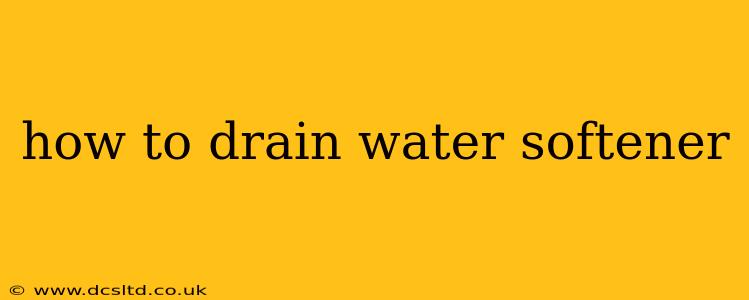Water softeners are essential for many households, removing hardness minerals like calcium and magnesium that can clog pipes and damage appliances. However, occasionally, you might need to drain your water softener. This could be for maintenance, repairs, or simply to prepare it for winterizing. This guide will walk you through the process, addressing common questions and concerns along the way.
Why Drain Your Water Softener?
Before diving into the "how," let's understand the "why." Draining your water softener is typically necessary in these situations:
- Maintenance: Regular draining and flushing help remove sediment buildup and ensure optimal performance. This prevents scaling and keeps your softener working efficiently.
- Repairs: If your water softener malfunctions, draining it may be a necessary step before troubleshooting or repair. A drained system is safer and easier to work on.
- Winterization: In colder climates, draining your water softener helps prevent freezing and potential damage to internal components.
- Relocation: If you're moving your water softener, draining it is essential to avoid spills and damage during transportation.
How to Drain a Water Softener: A Step-by-Step Guide
The specific steps for draining your water softener will depend on the model and brand. However, the general process is similar:
1. Turn Off the Power: Locate the power supply to your water softener and disconnect it. This is a crucial safety precaution to prevent electrical hazards.
2. Turn Off the Water Supply: Find the shut-off valves for the water supply lines leading to and from your water softener. Turn these valves completely off. This will prevent any further water from entering the system.
3. Locate the Drain Valve: Most water softeners have a drain valve located at the bottom of the unit. This valve may be a ball valve, a gate valve, or a similar type of valve.
4. Open the Drain Valve: Carefully open the drain valve, allowing the water to flow out. This may take some time depending on the size of your softener and the amount of water inside. Direct the draining water to a suitable drain or container.
5. Check for Complete Drainage: Once the water flow stops, it's important to verify that the tank is fully drained. You can usually tell by observing the water level through a sight glass (if equipped) or by simply checking that no more water is flowing from the drain valve.
6. Close the Drain Valve: Once the softener is completely drained, ensure to close the drain valve tightly to prevent leaks or future water ingress.
7. Restore Power and Water Supply (After Repairs/Maintenance): Once any maintenance or repairs are complete, restore the water supply by opening the shut-off valves and then reconnect the power supply.
What if My Water Softener Doesn't Have a Drain Valve?
Some older or less common models of water softeners may not have a dedicated drain valve. In such cases, you may need to consult your softener’s manual for specific draining instructions. This might involve disconnecting certain lines or using a pump to remove the water.
How Often Should I Drain My Water Softener?
The frequency of draining your water softener depends on several factors, including its usage, water quality, and your model's recommendations. However, it is generally recommended to drain and flush your softener at least once or twice a year, or as directed in your owner’s manual.
What Should I Do After Draining My Water Softener?
After draining, you should inspect the unit for any signs of damage, leaks, or mineral deposits. Cleaning the exterior and any accessible internal components can also be beneficial. Following the draining process, it's crucial to follow the manufacturer's instructions to properly restart and re-introduce salt to your water softener.
This comprehensive guide should provide you with the necessary information to safely and effectively drain your water softener. Remember, always consult your owner’s manual for specific instructions related to your model. If you're unsure about any part of the process, it's always best to contact a qualified plumber or water softener technician.
